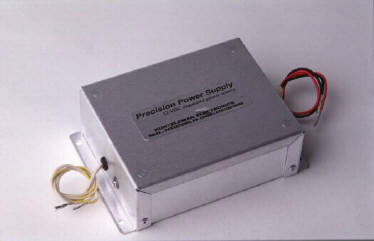Precision Power Supply
|
|
|
When connected to the lighting coil of the engine it
will provide 12 volts of pure noise free safe DC power @ 3 Amps.
This
power is used to operate radios, including CD, navigation equipment
such as GPS, DC powered gauges, etc.
|
|
|
The PPS
is a pass type-switching regulator, so it will not interfere with
tach, strobes or any other AC equipment. It can be used with or without
a battery in the system. When used with a small to medium sized battery
it will safely keep that battery charged.
It also features a watch dog
circuit to carefully monitor it's DC output. Thus eliminating the
danger of voltage surges and noise spikes damaging your expensive
equipment. The 4 1/2 x 3 1/2 inch unit weighs only 10
oz.. |
|
Double Dual Magnum 12 VDC
Driver box
ONLY
Price $140.00 U.S. |
|
|
|
|
 |
Comparing regulator
rectifiers
Most things are designed
with a specific use in mind and regulator rectifiers used
for converting alternating current (AC) to direct current (DC) at a
desired voltage level are no exception. Alternators, weather they are
Permanent Magnet (type used in two cycle and some four stroke engines)
or belt and gear driven, with a variable field (used in the general
aviation and automotive market) produce AC.
The Voltage level and
frequency of that AC is directly proportional to the speed, or RPMs of
the engine. That AC must be converted to DC and then regulated to a
safe and useable level to power various electrical devices. That level
should be between 13.2 and 14.3 volts. This voltage level will safely
charge a lead acid battery. A properly designed electrical system
should have a battery to stabilize the system. Under
certain circumstances the battery can be left out like in an ultralight
aircraft where the weight of a battery becomes a more important factor.
However, doing so one should be mindful of several hazards. Voltage
spikes, ripple (noise), higher than normal voltage levels, and worst of
all a failed regulator that shorts through and fries all the devices
(Radios, GPS, lights, etc.) down stream. The latter may not even be
prevented by having a battery installed. Also, a fuse will not protect
from over voltages. Fuses work on Amps not volts.
Having said all that, let
us now talk about the regulator rectifiers available to the
Ultralight and Experimental aircraft market. The SHUNT type, there are
several brands on the market, you know the ones priced around $60.
Their operation is fairly simple. Using an SCR (switch) controlled by a
Zener diode (voltage level sensor) they short out (shunt) the incoming AC
to control the voltage level (regulating before rectifying, this is why
the AC as well as the DC is lowered to 14 volts).
Then this voltage is
sent through a full wave bridge (four diodes) which convert it to DC.
Then on to a capacitor to filter out most of the ripple. One that is
widely used doesn't have the capacitor so you must add one externally.
A battery could be considered a very large capacitor. Shunt regulators
are encased in aluminum blocks to help dissipate the heat, some even
have cooling fans. They burn up a lot of power (Watts) by their short
circuit operation which creates that heat. A Rotax 503 or 582 at 6300
RPMs will put out as much as 90 to 100 volts.
Now, with this type
regulator that level is shorted down to 14 volts. All of this means
unnecessary
wasted horsepower from your engine. On the plus side, SHUNT
regulators are relativity inexpensive and produce larger current flow
(Amps).
If you need a lot of electrical power all of the time I
would suggest a Shunt type regulator connected to a battery of at least 17
Amp. hour capacity. Nothing smaller and NEVER without a battery. To do
so is playing Russian Roulette with your expensive equipment. One more
thing I would like to mention on shunts. There is a very inexpensive
($25) 2" X 2" square block with 2 yellow, 1 red, and 1 black wire that is
being sold as a shunt regulator that works if it has a 1 Amp load. This
is true only if used on the 30 watt
(green) coil of the older point
equipped engines.
If you are not using an
electric starter and high amperage consumers like landing lights
you may want to read about a SWITCHING type regulated power supply
built by Kuntzleman Electronics. The Precision Power Supply
uses a full wave bridge to change the incoming AC to DC. This DC is
then pre filtered and sent to a precision switching regulator that is
controlled by an integrated circuit.
Through sampling the output, this
IC controls the regulator for an accurate level of 13.8 volts +/- 1%
and current limiting to 3 Amps. A quality monitoring circuit takes a look
and if all is okay the power is filtered again and sent on to be used.
If the monitor sees anything that isn't okay (higher than safe voltage
levels even spikes) it shuts down the system (crowbar)
within microseconds, long before any damage is done to your expensive
radios.
So, you can see this is not just a regulator rectifier. It is a
regulator power supply producing pure filtered 13.8 volts
DC, regardless of load, up to its 3 amp limit. It is over voltage
protected and short circuit proof. If a short should occur somewhere in
your electrical system the regulator will simply turn down the
voltage
until the short circuit is removed. This supply will not put an excess
load on the engine. It
only produces what your equipment is asking for,
nothing extra only to be wasted as heat. The PPS
can be used with or
without a battery on any single phase alternator, no matter how high
the Wattage rating.
Your electronic equipment as well as your engine is
expensive and should have a long life if taken care of and fed
properly. You wouldn't think of using a poor grade of gas or oil in
your engine. So why feed your electronics a poor grade of
power?
|
|
|
|
|
1 2 3 4 5 6 7 8 9 10 11
Index for this section. |
|
Ultralight Aircraft News.ca Web Magazine Resource Site .
No part of this
publication may be copied or distributed, transmitted, transcribed,
stored in a retrieval system, or translated into any human or computer
language, in any form or by any means, electronic, mechanical,
manual, or otherwise, without written permission .
By copying or paraphrasing the intellectual
property on this site, you're automatically signing a binding contract
and agreeing to be billed $10,000 payable immediately. Copyright UltralightNews.ca
|


